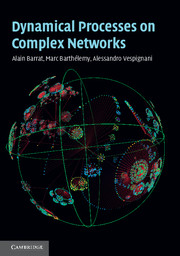Book contents
- Frontmatter
- Contents
- Preface
- Acknowledgements
- List of abbreviations
- 1 Preliminaries: networks and graphs
- 2 Networks and complexity
- 3 Network models
- 4 Introduction to dynamical processes: theory and simulation
- 5 Phase transitions on complex networks
- 6 Resilience and robustness of networks
- 7 Synchronization phenomena in networks
- 8 Walking and searching on networks
- 9 Epidemic spreading in population networks
- 10 Social networks and collective behavior
- 11 Traffic on complex networks
- 12 Networks in biology: from the cell to ecosystems
- 13 Postface: critically examining complex networks science
- Appendix 1 Random graphs
- Appendix 2 Generating functions formalism
- Appendix 3 Percolation in directed networks
- Appendix 4 Laplacian matrix of a graph
- Appendix 5 Return probability and spectral density
- References
- Index
11 - Traffic on complex networks
Published online by Cambridge University Press: 05 September 2012
- Frontmatter
- Contents
- Preface
- Acknowledgements
- List of abbreviations
- 1 Preliminaries: networks and graphs
- 2 Networks and complexity
- 3 Network models
- 4 Introduction to dynamical processes: theory and simulation
- 5 Phase transitions on complex networks
- 6 Resilience and robustness of networks
- 7 Synchronization phenomena in networks
- 8 Walking and searching on networks
- 9 Epidemic spreading in population networks
- 10 Social networks and collective behavior
- 11 Traffic on complex networks
- 12 Networks in biology: from the cell to ecosystems
- 13 Postface: critically examining complex networks science
- Appendix 1 Random graphs
- Appendix 2 Generating functions formalism
- Appendix 3 Percolation in directed networks
- Appendix 4 Laplacian matrix of a graph
- Appendix 5 Return probability and spectral density
- References
- Index
Summary
The main role of many networks is to provide the physical substrate to the flow of some physical quantity, data, or information. In particular, this is the case for the transportation and technological infrastructures upon which the everyday functioning of our society relies. In this context, congestion phenomena, failures, and breakdown avalanches can have dramatic effects, as witnessed in major blackouts and transportation breakdowns. Also, in technological networks, if the single element does not have the capacity to cope with the amount of data to be handled, the network as a whole might be unable to perform efficiently. The understanding of congestion and failure avalanches is therefore a crucial research question when developing strategies aimed at network optimization and protection.
Clearly the study of network traffic and the emergence of congestion and large scale failures cannot neglect the specific nature of the system. The huge literature addressing these questions is therefore domain oriented and goes beyond the scope of this book. On the other hand, large-scale congestion and failure avalanches can also be seen as the emergence of collective phenomena and, as such, studied through simple models with the aim of abstracting the general features due to the basic topology of the underlying network. This chapter is devoted to an overview of results concerning traffic, congestions, and avalanches and is more focused on the general and ubiquitous features of these phenomena than on system-specific properties.
- Type
- Chapter
- Information
- Dynamical Processes on Complex Networks , pp. 242 - 266Publisher: Cambridge University PressPrint publication year: 2008



